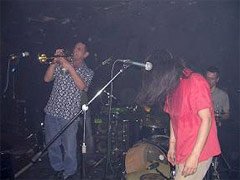
| HOME |
| NERVE |
| REVIEWS |
| ARCHIVE |
| EVENTS |
| LINKS |
| ABOUT US |
| CONTRIBUTORS |
| BACK ISSUES |
| CONTACT US |
 Damo Suzuki’s
Network/Zukanican
Damo Suzuki’s
Network/Zukanican
The Zanzibar, Seel Street
31st March 2006
Reviewed by Matthew Ford
At the Philharmonic Hall in Hope Street, US Secretary of State Condoleezza Rice attended a concert by the Philharmonic Orchestra (that is, apart from those members who refused to take part) as part of her controversial visit to Liverpool, where she was accompanied by British Foreign Secretary Jack Straw. Anti-war protesters - most sources say as many as 2,000 in number - came out to march against the city’s unwelcome guests - whose intention is to destroy the world in which they have to live. The demonstration was mostly peaceful.
Less than 250 yards away from the Philharmonic - in the very different surroundings of Seel Street’s Zanzibar club - perhaps as many as 60 music lovers gathered to witness Japanese former Can 'frontman' - and that’s a term which should be used loosely - Kenji ‘Damo’ Suzuki. Many of the audience members had come straight from the aforementioned ‘demo’.
The Zanzibar is a small venue. There’s broken glass on the floor, and the smell of alcoholic beverages in the air. In the toilets, the walls, ceiling and floor are covered in holes, piss and graffiti, and the smell is disgusting. One cubicle has no door, the other has no lock, and there is no soap to wash your hands with. What a perfect setting for revolutionary, anarchistic music.
Damo Suzuki is on a ’Never-ending’ world tour. As is the case whenever he visits Liverpool - which happens at least once or twice a year - he was joined by experimental Liverpool jazz collective Zukanican. The band - whose numbers vary from gig to gig - have been playing the kind of ‘Krautrock’-style grooves that Can brought to the musical table in the 70s for years now, augmenting it with a jazz style that is all their own. Also similarly to Can, the band members utilise whatever instruments they can find. Well, all that is except for rock music’s best friend, the six-stringed guitar. The band used so many instruments throughout the two-hour performance - which ended at around 2am - that it was difficult to keep track, but the vast array included bass, drums and a myriad percussive instruments, sax, trumpet - both with and without a mute, flute, sitar guitar and accordion, plus various electronics. At times, band members seemed to spend mere seconds on a particular instrument before changing to yet another, completely different one. Not that it made any difference for the audience, which included local legend Stan the harpist. The crowd was worked up into a frenzy, many of them unable to control their dancing. You can’t blame them either. It was great to see the power that this music had over its audience.
The rhythm section - which includes the superbly funky bassist Tom Sumnall - was very much at the fore as usual, and that’s where a lot of the energy came from. The other musicians merely served to compliment the driving beat, but that’s not to underestimate the significance of their contribution; at concerts such as this - where each piece is entirely improvised - no band member or audience is more important than any other. Everyone in the room - and perhaps even the room itself - contributes to the music. Every musician responds to every other musician as well as the audience, who in turn respond back again, with their collective energies being propelled from the stage to the floor, and back again. It’s a cyclical process which eventually ends - even the best cyclists will get tired eventually - although theoretically it has the potential to go on forever. There are no rehearsals, and absolutely anything could happen at any point. This is not - as you might expect with rock music - about ego. Everyone is equal, and everyone gets their chance to shine.
Suzuki himself ebbed and flowed with the music. Often, he went for minutes at a time without making a sound, while at other times he was positively frantic with enthusiasm. As ever, he utilised his familiar clean singing tone, but he also employed his more recent and slightly frightening Lemmy-esque ’cookie monster’ vocal growl. As was always the case with his days in Can, it is difficult if not impossible to make out exactly what he is singing. Along with his varied vocal approach, Damo has always been known for singing in English, German or Japanese - often in quick succession. It all depends on the fickle nature of his own personal whim, but this doesn’t matter one bit. The focus is not on words, or even Suzuki himself as the vocalist. Instead, the listener is meant to focus on the music as a complete entity. After all, the voice is just another instrument and another texture.
Damo Suzuki will undoubtedly be back in Liverpool in the not too distant future, and almost certainly with the superb musicians of Zukanican. You will dance like you’ve never danced before and like you never knew you could, and you will leave in the early hours filled with excitement, energy and awe. Every show is entirely unique, and it will be a night that you will never forget. The ‘Damonstration’ was a riot.
Damo Suzuki: http://www.damosuzuki.de/
Zukanican: http://www.myspace.com/zukanican